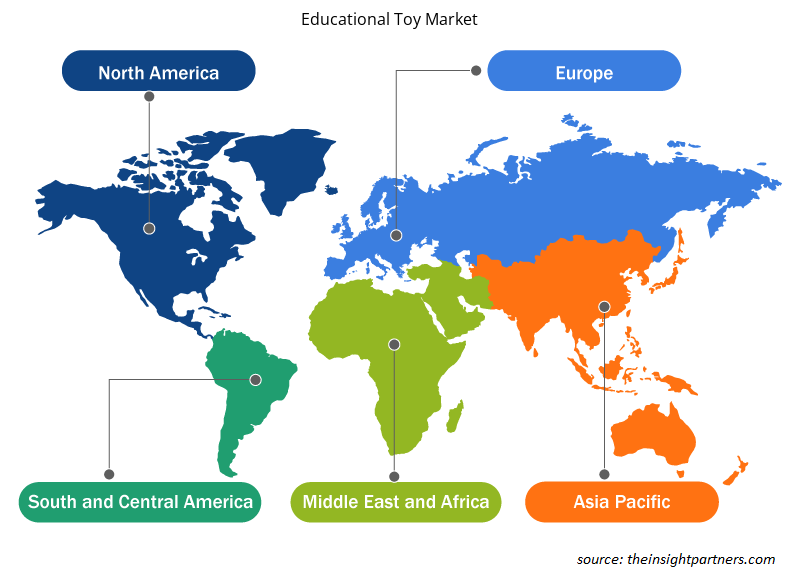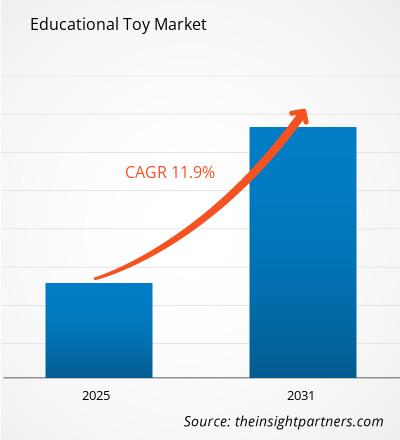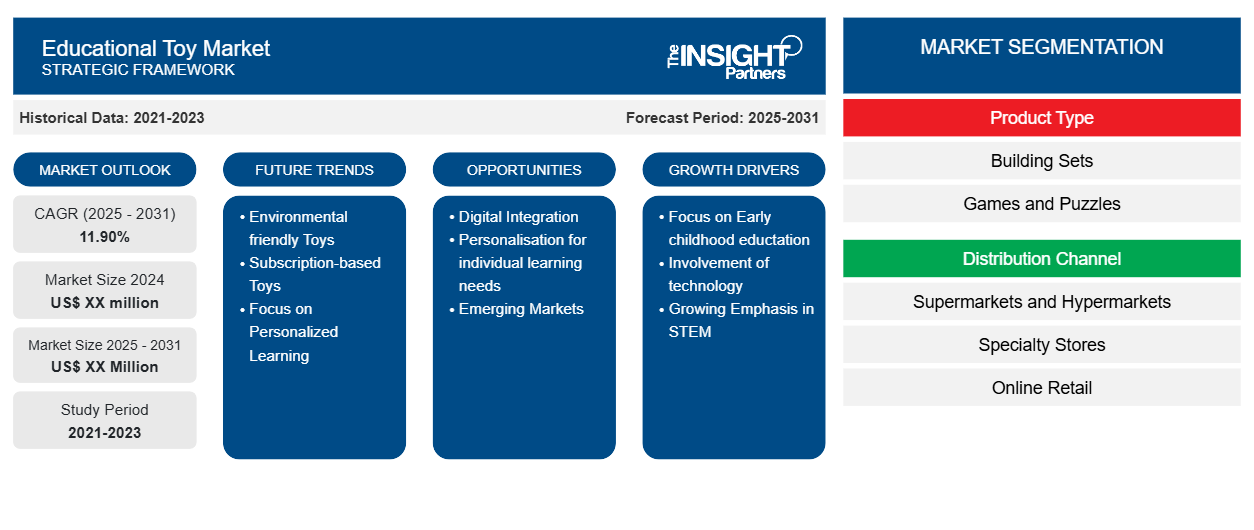Si prevede che il mercato dei giocattoli educativi registrerà un CAGR dell'11,90% dal 2023 al 2031, con una dimensione di mercato in espansione da XX milioni di dollari nel 2023 a XX milioni di dollari entro il 2031.
Questo rapporto di mercato sui giocattoli educativi fornisce un'analisi approfondita del mercato, segmentato per tipo di prodotto, fascia d'età e regione. Evidenzia le tendenze chiave che guidano il settore, come la crescente enfasi sull'apprendimento STEM e l'integrazione digitale nei giocattoli educativi. Le dimensioni del mercato e le proiezioni di crescita sono dettagliate, offrendo approfondimenti sulla domanda regionale e sulle dinamiche competitive. Gli stakeholder trarranno vantaggio dalla comprensione delle preferenze dei consumatori e dalle opportunità emergenti per innovare all'interno di questo settore in espansione.
Scopo del rapporto
Il report Educational Toy Market di The Insight Partners mira a descrivere il panorama attuale e la crescita futura, i principali fattori trainanti, le sfide e le opportunità. Ciò fornirà spunti a vari stakeholder aziendali, come:
- Fornitori/produttori di tecnologia: per comprendere le dinamiche di mercato in evoluzione e conoscere le potenziali opportunità di crescita, consentendo loro di prendere decisioni strategiche informate.
- Investitori: condurre un'analisi completa delle tendenze relative al tasso di crescita del mercato, alle proiezioni finanziarie del mercato e alle opportunità esistenti lungo la catena del valore.
- Enti di regolamentazione: regolamentano le politiche e le attività di controllo sul mercato allo scopo di ridurre al minimo gli abusi, preservare la fiducia degli investitori e sostenere l'integrità e la stabilità del mercato.
Segmentazione del mercato dei giocattoli educativi
Tipo di prodotto
- Set di costruzione
- Giochi e puzzle
Canale di distribuzione
- Supermercati e Ipermercati
- Negozi specializzati
- Vendita al dettaglio online
Personalizza questo report in base alle tue esigenze
Riceverai la personalizzazione gratuita di qualsiasi report, comprese parti di questo report, o analisi a livello nazionale, pacchetto dati Excel, oltre a usufruire di grandi offerte e sconti per start-up e università
- Scopri le principali tendenze di mercato in questo rapporto.Questo campione GRATUITO includerà analisi di dati che spaziano dalle tendenze di mercato alle stime e alle previsioni.
Fattori trainanti della crescita del mercato dei giocattoli educativi
- Attenzione all'educazione della prima infanzia: il mercato dei giocattoli educativi sta crescendo a un ritmo accelerato, man mano che aumenta l'attenzione all'apprendimento educativo e evolutivo della prima infanzia.
- Coinvolgimento della tecnologia: i giocattoli sono sempre più incoraggiati come strumenti per lo sviluppo delle capacità cognitive, sociali e motorie nei bambini, e il coinvolgimento della tecnologia nei giocattoli educativi, soprattutto sotto forma di sistemi di apprendimento interattivi e app, è anch'esso un motore della crescita del mercato.
- Crescente importanza per le materie STEM: la crescente importanza dell'istruzione STEM (scienza, tecnologia, ingegneria e matematica), soprattutto nella fase prescolare, sta determinando una crescente domanda di giocattoli mirati a stimolare la risoluzione dei problemi e il pensiero analitico.
Tendenze future del mercato dei giocattoli educativi
- Giocattoli rispettosi dell'ambiente: la tendenza verso l'uso di materiali sostenibili e rispettosi dell'ambiente riflette la crescente importanza di questioni come l'impatto ecologico a cui i consumatori stanno diventando sempre più consapevoli, mentre il crescente desiderio di giocattoli che supportino diversi stili di apprendimento (ritenuti particolarmente adatti ai bambini con disabilità neurovegetativa), compresi i giocattoli sensoriali, è illustrato dalla tendenza successiva, ovvero l'abbonamento ai giocattoli.
- Giocattoli in abbonamento: la fornitura di giocattoli educativi tramite box in abbonamento è in ascesa, poiché i consumatori cercano offerte incentrate sull'istruzione consegnate regolarmente a casa loro. Questa analisi delle tendenze delinea in dettaglio le ultime dinamiche di mercato, le esigenze dei consumatori in termini di prodotti ed esperienza, nonché le attuali offerte di prodotti sul mercato da parte di produttori e rivenditori. Queste informazioni sono inestimabili per le aziende nel determinare quali prodotti e servizi modificare per rimanere rilevanti sul mercato.
- Focus sull'apprendimento personalizzato: i giocattoli educativi che possono essere adattati alle esigenze di apprendimento individuali di un bambino stanno guadagnando terreno. I prodotti che si adattano al livello di abilità di un bambino o forniscono feedback e sfide personalizzati sono considerati più efficaci nel promuovere l'apprendimento a lungo termine.
Opportunità di mercato dei giocattoli educativi
- Integrazione digitale: con la proliferazione delle piattaforme di apprendimento online, i giocattoli educativi sono stati integrati con la loro controparte digitale. Crea un'esperienza di apprendimento ibrida utilizzando il meglio di entrambi i mondi.
- Personalizzazione in base alle esigenze di apprendimento individuali: la tendenza crescente dell'istruzione personalizzata rappresenta un'ulteriore opportunità di crescita per il settore. Gli attori del settore, come i marchi, possono sviluppare giocattoli con elementi personalizzabili per soddisfare le esigenze di apprendimento individuali.
- Mercati emergenti: inoltre, il potenziale di crescita può essere sfruttato nei mercati emergenti in cui le famiglie sono alla ricerca di risorse educative di qualità. Questa categoria di crescita ambiziosa può aiutare a incrementare il consumo complessivo delle famiglie. Questa sezione del rapporto descriverà in dettaglio le opportunità, svelerà proiezioni delle dimensioni del mercato in milioni e miliardi e strategie approfondite che aiuteranno le aziende a identificare e approfondire nuove opportunità di crescita nel settore dei giocattoli educativi.
Approfondimenti regionali sul mercato dei giocattoli educativi
Le tendenze regionali e i fattori che influenzano il mercato dei giocattoli educativi durante il periodo di previsione sono stati ampiamente spiegati dagli analisti di Insight Partners. Questa sezione discute anche i segmenti e la geografia del mercato dei giocattoli educativi in Nord America, Europa, Asia Pacifico, Medio Oriente e Africa e America meridionale e centrale.

- Ottieni i dati specifici regionali per il mercato dei giocattoli educativi
Ambito del rapporto sul mercato dei giocattoli educativi
| Attributo del report | Dettagli |
|---|---|
| Dimensioni del mercato nel 2023 | XX milioni di dollari USA |
| Dimensioni del mercato entro il 2031 | XX milioni di dollari USA |
| CAGR globale (2023-2031) | 11,90% |
| Dati storici | 2021-2022 |
| Periodo di previsione | 2024-2031 |
| Segmenti coperti | Per tipo di prodotto
|
| Regioni e Paesi coperti | America del Nord
|
| Leader di mercato e profili aziendali chiave |
|
Densità degli attori del mercato dei giocattoli educativi: comprendere il suo impatto sulle dinamiche aziendali
Il mercato dei giocattoli educativi sta crescendo rapidamente, spinto dalla crescente domanda degli utenti finali dovuta a fattori quali l'evoluzione delle preferenze dei consumatori, i progressi tecnologici e una maggiore consapevolezza dei vantaggi del prodotto. Con l'aumento della domanda, le aziende stanno ampliando le loro offerte, innovando per soddisfare le esigenze dei consumatori e capitalizzando sulle tendenze emergenti, il che alimenta ulteriormente la crescita del mercato.
La densità degli operatori di mercato si riferisce alla distribuzione di aziende o società che operano in un particolare mercato o settore. Indica quanti concorrenti (operatori di mercato) sono presenti in un dato spazio di mercato in relazione alle sue dimensioni o al valore di mercato totale.
Le principali aziende che operano nel mercato dei giocattoli educativi sono:
- Giochi di Atlante
- Clementoni SpA
- Giochi di Golia
- Marchio
- Il Gruppo LEGO.
Disclaimer : le aziende elencate sopra non sono classificate secondo un ordine particolare.

- Ottieni una panoramica dei principali attori del mercato dei giocattoli educativi
Punti di forza chiave
- Copertura completa: il rapporto affronta in modo completo l'analisi di prodotti, servizi, tipologie e utenti finali del mercato dei giocattoli educativi, fornendo una panoramica olistica.
- Analisi degli esperti: il rapporto è compilato sulla base della conoscenza approfondita di esperti e analisti del settore.
- Informazioni aggiornate: il rapporto garantisce la pertinenza aziendale grazie alla copertura di informazioni recenti e tendenze nei dati.
- Opzioni di personalizzazione: questo report può essere personalizzato per soddisfare le esigenze specifiche del cliente e adattarsi in modo appropriato alle strategie aziendali.
Il rapporto di ricerca sul mercato dei giocattoli educativi può quindi aiutare a guidare il percorso di decodificazione e comprensione dello scenario del settore e delle prospettive di crescita. Sebbene possano esserci alcune preoccupazioni valide, i vantaggi complessivi di questo rapporto tendono a superare gli svantaggi.
- Analisi storica (2 anni), anno base, previsione (7 anni) con CAGR
- Analisi PEST e SWOT
- Valore/volume delle dimensioni del mercato - Globale, Regionale, Nazionale
- Industria e panorama competitivo
- Set di dati Excel
Report recenti
Testimonianze
Motivo dell'acquisto
- Processo decisionale informato
- Comprensione delle dinamiche di mercato
- Analisi competitiva
- Analisi dei clienti
- Previsioni di mercato
- Mitigazione del rischio
- Pianificazione strategica
- Giustificazione degli investimenti
- Identificazione dei mercati emergenti
- Miglioramento delle strategie di marketing
- Aumento dell'efficienza operativa
- Allineamento alle tendenze normative





















 Ottieni un campione gratuito per - Mercato dei giocattoli educativi
Ottieni un campione gratuito per - Mercato dei giocattoli educativi